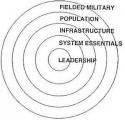Whoh there my big furry friend. The racer analogy is the very fallacy I was trying to address.
Trying to be faster is pointless. "Speed" (action faster then reaction) can only relate to the generation of surprise - the enemy being un-prepared for your action, which is why concealing an action is far better than competing in time and space. - which suggests than actions that impeded the enemy's ability to effectively prepare are those which are the most worthwhile.
This is where I don't get the OODA loops "speed of cycling" thing. A lot of stuff in a 7,000 man armoured brigade takes the time that it does, just because it cannot be done faster. - and if it was it would make not that much difference.











 All problems that are solved by human beings go through a 4 step process.
All problems that are solved by human beings go through a 4 step process.




Bookmarks